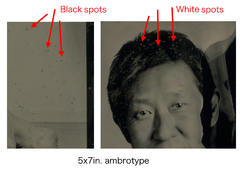Hi, I work on wet plate photography and these are part of the scanned images of the plates that I recently made.
Can you identify these white and black marks (spots)?
Both of them are ambrotypes. They were not from one shoot session though.
I used a moderately new collodion and developer. My silver bath has been recently maintainanced (1 month ago).
Is it possible to have these marks (dusts?) if the plates aren't clean enough?
Thank you in advance.
Can you identify these white and black marks (spots)?
Both of them are ambrotypes. They were not from one shoot session though.
I used a moderately new collodion and developer. My silver bath has been recently maintainanced (1 month ago).
Is it possible to have these marks (dusts?) if the plates aren't clean enough?
Thank you in advance.







